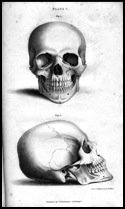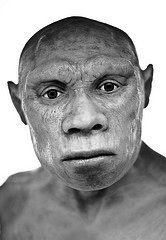craniometry
Measuring cranial variation using geography as a proxy for neutral genetic distances
14/08/09 15:35 Filed in: Biological Anthropology
Certain anatomical features of the human skeleton are known to vary with geography and climate. To what extent each variable contributes to our physical makeup is less clear. The problem is that populations with similar climate are geographically close to one another. Even if we find shared traits among populations from similar climates it may be just as a result of geographic proximity (and thus clinal gene flow), rather than shared common ancestry.
As I mentioned in my previous post, anthropologists often compared cranial data to matched microsatellite datasets. However, it is rarely possible to get an exact match between the cranial and microsatellite populations. The anthropologist will instead use populations that are genetically similar and which may or may not be representative of the target population. Another option is to substitute microsatellite data with geographic distances, since studies have found a strong correlation between genetic distance and geographic distance (Manica et al. 2005; Ramachandran et al. 2005; Romero et al. 2008). This allows us to get around the need to match phenotypic data with genetic datasets. Read More...
As I mentioned in my previous post, anthropologists often compared cranial data to matched microsatellite datasets. However, it is rarely possible to get an exact match between the cranial and microsatellite populations. The anthropologist will instead use populations that are genetically similar and which may or may not be representative of the target population. Another option is to substitute microsatellite data with geographic distances, since studies have found a strong correlation between genetic distance and geographic distance (Manica et al. 2005; Ramachandran et al. 2005; Romero et al. 2008). This allows us to get around the need to match phenotypic data with genetic datasets. Read More...
0 Comments
Examining cranial robusticity
08/08/09 19:23 Filed in: Biological Anthropology
Palaeoanthropologist Darren Curnoe (2009) gives the following biological definition of the term ‘robust’:
…a descriptive anatomical term referring to individuals, complexes, organs, structures or traits which are heavily built, rugged, well defined or corpulent.
Bones tend to more robust where muscles, tendons or ligaments insert into the periosteum. When these insertion sites are subjected to stress, blood flow increases. This in turn stimulates the production of osteoblasts, which lay down extra bone. With respect to the skull the term robust is generally used to refer to so-called superstructures, such as the supraorbital ridges, occipital crests or zygomaxillary tuberosities. Anthropologists often classify robusticity based on the relative expression of a particular trait, or indeed its absence. Given that robusticity is related to physical stress, traits tend to be more pronounced in males and in certain populations (e.g. Aboriginal Australians and Fuegians).
The retention of robust features in certain populations, particularly Aboriginal Australians, has been used to support the multiregional hypothesis of human origins (e.g. Wolpoff et al. 2001; Frayer et al., 1993). On the other hand, proponents of a replacement model see robust traits (e.g. in Australian Aboriginal populations) as retained plesiomorphies and argue that these traits cannot be used to show continuity (Lieberman 2000). In response, many multiregionalists have revised their position to suggest that the reduction of the browridge in later Neandertals, such as St Césaire and Vindija, represents a synapomorphy between Neandertals and modern humans, likely due to interbreeding. The underlying assumption here is that these robust traits have a strong genetic component. Furthermore, there is a notable decrease in cranial robusticity from the early Upper Palaeolithic to late Upper Palaeolithic. It has been suggested that this may reflect changes in diet. Transition from hunter-gather to agricultural lifestyle is associated with a reduction in cranial robusticity, although correlation does not necessarily prove causation. However, not all hunter-gather groups are universally more robust than argriculturalists, which might suggest some other factors at play. Read More...
…a descriptive anatomical term referring to individuals, complexes, organs, structures or traits which are heavily built, rugged, well defined or corpulent.
Bones tend to more robust where muscles, tendons or ligaments insert into the periosteum. When these insertion sites are subjected to stress, blood flow increases. This in turn stimulates the production of osteoblasts, which lay down extra bone. With respect to the skull the term robust is generally used to refer to so-called superstructures, such as the supraorbital ridges, occipital crests or zygomaxillary tuberosities. Anthropologists often classify robusticity based on the relative expression of a particular trait, or indeed its absence. Given that robusticity is related to physical stress, traits tend to be more pronounced in males and in certain populations (e.g. Aboriginal Australians and Fuegians).
The retention of robust features in certain populations, particularly Aboriginal Australians, has been used to support the multiregional hypothesis of human origins (e.g. Wolpoff et al. 2001; Frayer et al., 1993). On the other hand, proponents of a replacement model see robust traits (e.g. in Australian Aboriginal populations) as retained plesiomorphies and argue that these traits cannot be used to show continuity (Lieberman 2000). In response, many multiregionalists have revised their position to suggest that the reduction of the browridge in later Neandertals, such as St Césaire and Vindija, represents a synapomorphy between Neandertals and modern humans, likely due to interbreeding. The underlying assumption here is that these robust traits have a strong genetic component. Furthermore, there is a notable decrease in cranial robusticity from the early Upper Palaeolithic to late Upper Palaeolithic. It has been suggested that this may reflect changes in diet. Transition from hunter-gather to agricultural lifestyle is associated with a reduction in cranial robusticity, although correlation does not necessarily prove causation. However, not all hunter-gather groups are universally more robust than argriculturalists, which might suggest some other factors at play. Read More...
The impact of cranial plasticity on the reconstruction of human population history
27/07/09 14:28 Filed in: Biological Anthropology
Palaeoanthropologists are interested in reconstructing the evolutionary history of our species from fossil remains. Like other taxonomists they are primarily interested in identifying shared derived traits, otherwise known as synapomorphies. A synapomorphic trait is shared by some members of a taxa and not by others, since the former inherited this trait from a common ancestor. For instance, the retention of a clavicle (collar bone) is one of the more cited synapomorphic traits common to all primates.
A homoplasy is a trait that is present in two or more taxa but that has not been derived through common ancestry but rather through convergence, parallelism, or reversal. The wings of insects, birds and bats are homoplasies, since they arose through convergent evolution. Thus, homoplasies and synapomorphies may be identical in appearance but are distinguished by whether or not they arose through common ancestry. As a result, it can often difficult to pry apart traits which are synapomorphies from those which are homoplasies. A subset of homoplasies are termed homoiologies. Lycett and Collard (2005) define homoiologies as:
“… phylogenetically misleading resemblances among a group of taxa that can be ascribed to phenotypic plasticity. That is, homoiologies are homoplasies that result from the expression by a genotype of different phenotypes in response to different environmental conditions.” Read More...
A homoplasy is a trait that is present in two or more taxa but that has not been derived through common ancestry but rather through convergence, parallelism, or reversal. The wings of insects, birds and bats are homoplasies, since they arose through convergent evolution. Thus, homoplasies and synapomorphies may be identical in appearance but are distinguished by whether or not they arose through common ancestry. As a result, it can often difficult to pry apart traits which are synapomorphies from those which are homoplasies. A subset of homoplasies are termed homoiologies. Lycett and Collard (2005) define homoiologies as:
“… phylogenetically misleading resemblances among a group of taxa that can be ascribed to phenotypic plasticity. That is, homoiologies are homoplasies that result from the expression by a genotype of different phenotypes in response to different environmental conditions.” Read More...
Is craniometry scientific?
13/05/09 10:07 Filed in: Biological Anthropology | Scepticism




